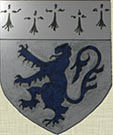Page 37.
SKELTON PARISH CENSUS 1821.
THE PARISH CHURCH REGISTER.
The following photocopy of page 42 of the Skelton Parish Register of Baptisms for 1821 has been contributed by Margaret Long of Maryland,
USA.
Many of her ancestors lived in the Skelton area at this time before emigrating to America.
The entries in the Register have been made by the Rev William Close, who was the curate at the old All Saints Church near Skelton Castle
from 1816 to 1857, when he died at the age of 75.
He must have been conscious of recording History, as he has noted at the bottom of the page the population of his Skelton Parish at the
census of this year, 1821.
It was 1235.
Skelton Parish extended out from the village as far as Moorsholm, some 3 to 4 miles away in those times and for long after.
The actual village population was around 750 as later censuses show.
Censuses began in 1801, but it was not until 1841 that names of individuals were recorded.
Each page of the Parish Registers tells a story.
The first parent was a Shoemaker, also known in those times as Cordwainers and they were so
vital that there were 6 in a small community.
The second name was famous in these parts. James Andrew, farmer, was the son and Grandson of the two
Johns, the notorious smugglers.
The third one is Isabella Fletcher, who committed the then disgraceful offence of having an illegitimate
child. She could have been on the list of females receiving compulsory support from the father in the Overseers of the Poor Account Book
shown earlier in this section but does not appear there.
The next two are twins.
Then a Tailor. In 1801 there were 9 to serve this small area.
Next come the MacNaughtons, who were Flax Dressers, a long process to make the flax plant ready for spinning into the thread to make linen.
"After harvesting, combing or rippling the flax stems removed the seed heads. The stems were then tied up in stooks, and placed in
water-filled pits for retting (meaning 'rotting'), decomposing through bacterial action for a week or two,
producing the most awful stench, but softening the glue between the plant fibres. The next stage took place at the local mill, where
scutching, beating the stems with a hinged batten to free the individual fibres, separated the useful fibres from the outer bark and
the central woody stem. At this stage the flax is still full of impurities, so heckling removed any remaining non-fibrous material by
drawing the stems through a big comb consisting of a bed of nails in a wooden board. Carding parted the fibres, breaking any natural
locks, and laying the fibres absolutely parallel to one another, in a form suitable for spinning. At this point, the process passed to
the womenfolk on the farm for them to spin the fibre on treadle-operated spinning wheels."
[The above description of the occupation is copied by kind permission from the webpage :-
"The Flax Trade - Why Robert Burns came to Irvine in 1781."]
And finally Robert Palister, the Labourer, of which there were 32 in 1801.
Sadly the death rate of infants in those times meant that on average half of these babies would never see the age of 5.
|



